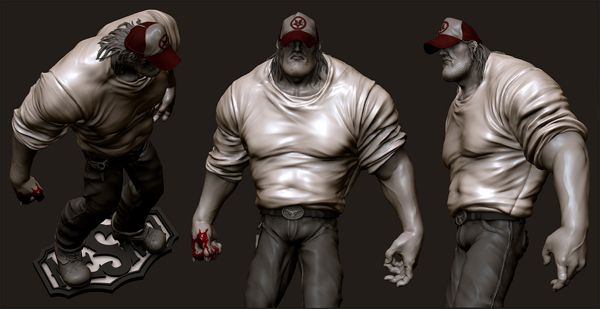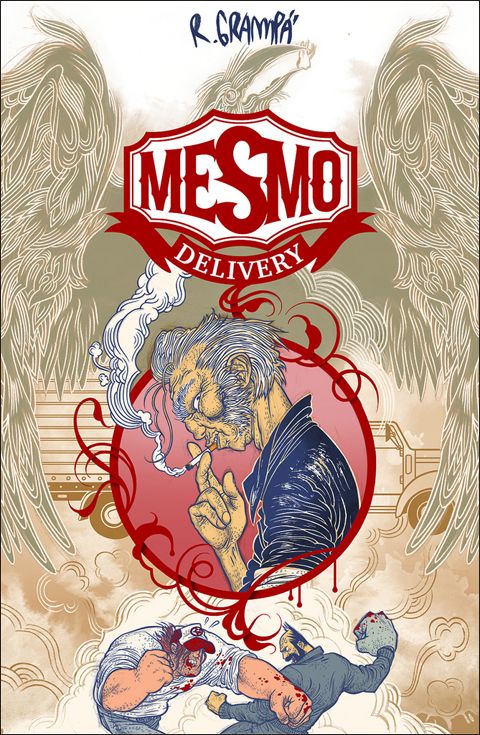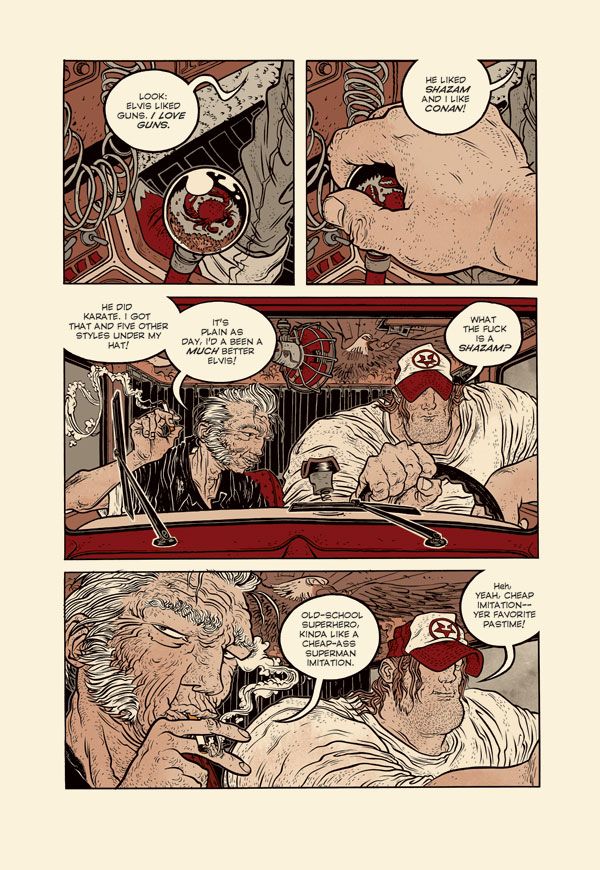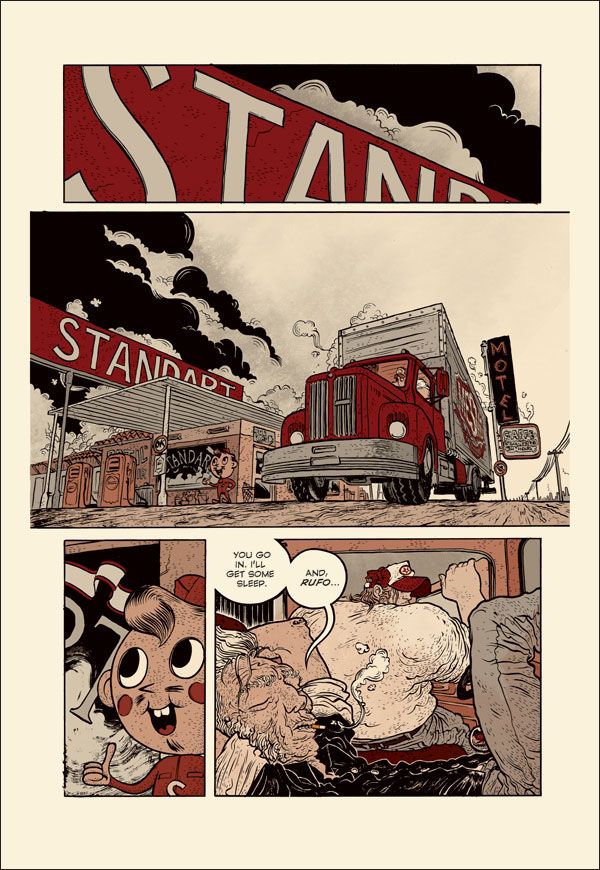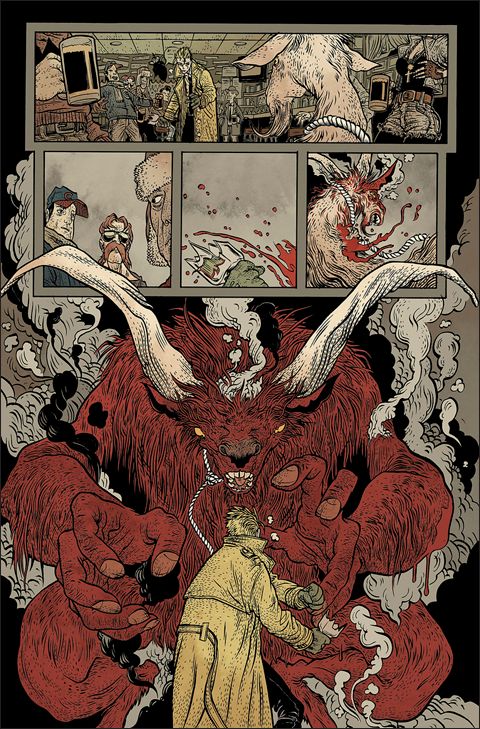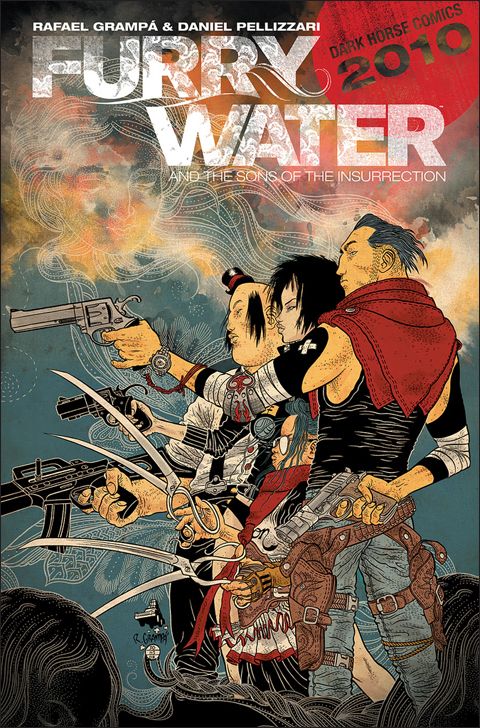Brazilian artist Rafael Grampá first attracted widespread attention in North America in 2007 with his work on the Eisner Award-winning anthology 5, a collaboration with Gabriel Bá, Becky Cloonan, Vasilos Lolos and Fabio Moon.
Grampá, a former art director for the respected motion-graphics studio Lobo, followed that in 2008 with Mesmo Delivery, his first full-length comics work.
Initially published in the United States by AdHouse Books, the graphic novella is a beautifully illustrated, energetic and bloody story about two delivery men -- Rufo, a brawny ex-boxer, and Sangrecco, an Elvis impersonator who views violence as performance art -- who are hired to deliver a mysterious cargo. Everything appears to be going fine, at least until they encounter a group of drunken locals at a rest stop.
Next week Dark Horse will release a new edition of the critically acclaimed Mesmo Delivery with a new cover, an extended sketchbook, an introduction by writer Brian Azzarello (who collaborated with Grampá on a story for Hellblazer #250), and pin-ups by Eduardo Risso, Mike Allred, Craig Thompson and Fabio Moon.
Grampá took time over the weekend to discuss Mesmo, his influences, graphic design and his next Dark Horse release, Furry Water and the Sons of the Insurrection.
I've seen your art compared to everyone from Frank Quitely and Taiyo Motsumoto to Paul Pope and Geof Darrow. That's high praise, obviously. But do you find it more flattering or intimidating -- or do you give the comparisons any thought at all?
It's normal to compare something new to something that you are already familiar. It's easy to find a lot of very different references when you want to compare and it's funny what kind of combo these comparisons could result. I do it all the time when I see something new that reminds me another thing. It's a basic instinct.
I love all those artists, and some are my friends, and obviously I'm flattered because they're some of the best artists in comics today. Regarding Quitely's and Matsumoto's comparisons, I'm much more influenced by Moebius, who is also a huge influence to them. I love Darrow's work, like everyone, but I think the comparison is because we're both obsessed by details but our line of work and style are totally different. He's more realistic. And a better artist! To be compared with him is one of the highest praises I can receive. Paul Pope is an influence, and when we talked about it, he said, "I can't see the influence, it's totally you." I believe that he was trying to be kind, but his brush work is an influence, for sure, just like Goseki Kojima's brush also is. I can say that Jamie Hewlett, R. Crumb, Katsuhiro Otomo, Suehiro Maruo, Patrice Killofer, Winsor McCay and Walt Disney are real influences, too. And also Mauríco de Souza (when I was a little kid I learned to draw with his characters), Angeli and Laerte, the most-acclaimed cartoonists here in Brazil.
Mesmo Delivery was originally released in North America through AdHouse Books in 2008. How did this new edition from Dark Horse come about?
Chris [Pitzer] was the first publisher in the USA that believed in my work. AdHouse was really important to me and Mesmo Delivery because it was an independent comic book and Chris Pitzer decided to distribute it for me. I paid the printing and shipping from Brazil to USA by myself, with the support of Rodrigo Teixeira -- a Brazilian visionary -- and the 2,000 copies sold out really fast. I met [Dark Horse Associate Editor] Sierra Hahn in the SDCC 2008 and we talked a lot about working together. When she knew that MD was sold out, she was interested in re-printing it. Obviously I talked with Chris first and he thought it was a good idea to re-print Mesmo Delivery by Dark Horse Comics, and voilà!
You've cited Sam Peckinpah's Convoy as an inspiration for Mesmo Delivery. What is it about the trucker/road genre, or that film in particular, that appeals to you?
Convoy is a really silly movie, but I like it. In these days, I like it more because it's a Peckinpah film, and his style is a huge influence. Convoy was my childhood-favorite film because my father was the manager of a delivery company and the parking area use to be my playground, playing inside the trucks. When I decided to write my debut I went to my first references to find something that could be very personal, and the truck genre came to me. And also I'm a big fan of horror films and road movies and I tried to mix everything that I like to write a story that I would like to read.
Your background in graphic design is apparent throughout the book, from the logo on the side of the truck to the signs at the gas station to the vintage-style ads. Was it a conscious effort on your part to blend design elements and the sequential art?
It's one of the things that I'm really trying to evolve in my work. I worked as an art director and concept designer of motion graphics for a long time and I learned a lot of design rules and tricks. I still consider myself a designer, and I always try to create a page thinking like a designer. I usually say that I think that all my pages are created to be a poster. Of course, I can't do it for all the pages because the priority is to tell the story, but it's another obsession that I have.
I also used a lot of subliminal graphic massages in the story, to include a hidden evil twist. A small example is the inverted logotype of Rufo's cap. It's an upside-down TEXACO logotype, that looks like an inverted cross and pentagram, symbols of evil. It's the kind of thing that could announce that something bad will happen in the story, if the reader perceives it, a storytelling tool. The book is stuffed with those graphic messages, including this new cover. I'm crazy about this kind of storytelling tricks and I'm always searching for more graphic information to put in my stories.
We can tell stories with everything that comics propose to us and design elements, colors, diagrammatic, art direction, etc., are all storytelling tools. If you create a particular vocabulary of symbols, you'll have a personal touch in your stories and a peculiar dialogue with your readers. And at the same time you could contribute to the evolution of this media, which is very young and accepts everything in the pages, limited just by creativity and passion. The Oubapo movement and all the artists involved and guys like Chris Ware and David Mazzuchelli are great examples of contemporary contributors for the evolution of the graphic dialogue that I mentioned.
Can you talk a little about your choice of color palette? In Mesmo Delivery, as in your short story for Hellblazer #250 and even (to an extent) your cover for Dead of Night #4, you use lots of grays, brick reds, murky browns and, for accent, pale pink and goldenrod. It's a wonderful combination, but a bit unusual.
Thank you! I like to use colors that arouse my hunger! And, no, I don't like gray food like monkey brain!
I love to color my own stuff, and when I can do it, I will. If I can't, I'll try to create a color palette or something like that. Artists can talk through colors and when I decide for an unusual palette it's because I wanna tell something with it. Like: death = red + black!
Mesmo Delivery is undeniably brutal: Readers have front-row seats to blood, urine, gore -- you name it, we see it. Were you ever concerned that you'd shown too much, or gone too far?
Some writers and movie directors say that the strongest violence is the violence you don't show, just suggest. And it makes sense, but I don't agree 100 percent with it for Mesmo Delivery. The genre I choose for Mesmo Delivery plays with gore. I can't talk about evil, roads, street fights, blood and trucks without going deep in it, and it means trying to shock the readers with the images. I created a character that thinks murder is art, so I can't just suggest the "grand finale" of his show. I didn't want to put makeup on my choices to tell a violent story. It's s harder to show than just suggest in this case because you need to be very original and create really smart scenes. If you do it, the readers will remember how good your scene was and not about the gore things.
As savage as the fight scenes are, I find them absolutely mesmerizing. They're some of my favorite comic-book action sequences in recent memory. How did you approach the choreography of those scenes?
Thanks, man. I like to think I'm playing rock-'n'-roll without playing music. Music and comics are the same thing for me because one of the most important things in both is attitude. The difference is that I am the artist but the rock stars are the characters. Thinking this way, I'm always searching for wild scenes, with a lot of attitude. Choreography is attitude, it's part of the show. A fight scene needs to be a show, and it will always be in my stories.
Mesmo doesn't exactly have a neat-and-tidy ending. Is there a chance you could return to Rufo and Sangrecco, or are you finished with their story?
I love the strange feeling of the endings that could continue, like some of The Twilight Zone chapters and some of '70s horror-movie endings. I just tried to offer the same feeling for the readers. It's like to be slapped in the face and when you look for the aggressor, there's nobody there.
I really love those characters and, to tell you the truth, I'm thinking about creating an ongoing series for Mesmo Delivery in the future, with a lot of trucks delivering crazy stories and a lot of new delivery men. Mesmo Delivery is the name of a delivery company and they have a lot of trucks around the world. But I never talk about it with nobody because it's not a priority right now. My idea is -- maybe -- just write these new stories and invite some artist to draw.
On your blog you've posted photos of models for action figures of Rufo and Sangrecco. How did those come about? Will there be Mesmo Delivery action figures avaiable in comic stores soon?
It was modeled by the talented Brazilian artist Rafael Grassetti, who started the project by himself. When he sent me the 3D models, he blew my mind and we started talking about producing some action figures with a Chinese company. It is a project that stopped for now because we are waiting for a larger fan base. I think it could happen soon because of this new print from Dark Horse Comics.
You have another project coming out this year from Dark Horse: the six-issue Furry Water, with Daniel Pellizzari. Details about that miniseries have been pretty slim so far. Any chance you can give us more information? Is there a release date yet?
Yeah, Furry Water and the Sons of the Insurrection is my new son, and I'm really excited about it. We are holding the buzz around Furry Water because we still have a lot of work to finish.
The post-Apocalyptic saga is set 70 years after the "Furry Water" plague hit, and the survivors remain ignorant about the cause of the devastation. Against this backdrop, we meet the Nobunagas, a family of outlaws who have a family obligation to re-start the insurrection against an "optimist-oppressive" regime. At the same time, these four brothers and a sister are searching for the fifth brother, who may or may not exist, and that is destined to lead the insurrection. It's a violent poetry about brotherhood, honor and faith. About what the human beings can do to support something that they believed their whole life when it's ruining.
We don't have a release date yet. It's an epic story and we' re giving the best of all of us and I'm sure the readers will be satisfied, after waiting a little longer, when they get the book on their hands. It's my best work. My friend Daniel Pellizzari -- a brilliant mind and the co-writer of the series -- and myself are doing our best in the script -- really crazy stuff -- and I can see my evolution as an artist and storyteller. If people liked Mesmo Delivery, they don't imagine what we are preparing.
You can read a 10-page preview of Mesmo Delivery here. The graphic novella arrives in stores next week.

